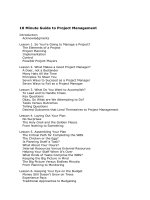Time Management Part 4 doc
Bạn đang xem bản rút gọn của tài liệu. Xem và tải ngay bản đầy đủ của tài liệu tại đây (299.71 KB, 14 trang )
42
4
Everyone does it. Everyone feels guilty when they do it.
And everyone resolves never to do it again. But they do.
Everyone procrastinates. Procrastination—the cat burglar
of time management—steals into your life and whisks
away one of the most valuable assets you possess.
O
f course, not everyone regrets putting things off. Indeed,
some people—having decided that it’s so ingrained in
human nature that there’s no use struggling against it—take
pride in their status as procrastinators. There’s even a National
Procrastinators Club. Really. You can find out all about it at
www.procrastinators.org. It has about 10,000 members—no one
is really sure, though, since the full list has never been compiled
or completed. The group occasionally tries to have meetings,
but customarily postpones them. The same person was presi-
dent for decades because the club never got around to holding
new elections. And dues well, collecting them must be an
interesting process.
Procrastination:
The Thief of Time
Mancini04.qxd 1/16/2003 4:28 PM Page 42
Copyright © 2003 by the McGraw-Hill Companies, Inc. Click here for Terms of Use.
Procrastination: The Thief of Time 43
What’s Behind Procrastination?
Procrastination can be a thoroughly amusing concept, indeed.
But, as with all things humorous, there are some underlying
deep and darker forces. At the root of procrastination, argue
psychologists, almost always lurks some hidden fear or conflict
that urges us to put things off. A person may be obliged to
achieve certain results, but a multitude of opposing emotions
serve to short-circuit action. Although the procrastinator may
act as if the threat, fear, or conflict is gone, it’s still there—both
in the real world and in the person’s subconscious—where it
generates stress and, ultimately, corrodes success.
Time management experts have identified the eight most
typical causes of procrastination, shown in Figure 4-1.
Internal Forces
Note that four of the causes (those in the shaded boxes) are pri-
marily inner rooted. They arise, for the most part, from the pro-
crastinator’s psyche. When we have certain tendencies or per-
Procrastination
Overwhelming
Tasks
Unclear
Task Flow
Unclear
Goals
Fear of
Change
Unpleasant
Tasks
Addiction to
Cramming
Tendency to
Overcommit
Fear of
Failure
Figure 4-1. Causes of procrastination
Mancini04.qxd 1/16/2003 4:28 PM Page 43
Time Management44
sonality traits, they can manifest themselves in very different
situations. If, for example, you tend to fear failure and you pro-
crastinate largely for that reason, you’ll procrastinate on any
task at which you might fear that you’ll fail.
If you answer yes to any of the following questions, you may
have the tendency to procrastinate embedded in your personality:
• While in school, did you usually cram before a test?
• Do you often put off returning a call to someone you
don’t like, even if it’s important?
• Do youb wait until you have dental problems to see your
dentist?
• Have you had an unintentional late finance charge in the
last three months?
• Do you wait until a deadline looms before beginning
important projects?
To defeat procrastination you need to put considerable ener-
gy into behavior change. Sound impossible? It’s not. A number
of proven and clear strategies can enable you to effect genuine
and lasting change.
External Forces
Even if you usually don’t procrastinate, your environment can
impose procrastination on you. Figure 4-1 gives, in the clear
unshaded boxes, the four typical external reasons for procrasti-
nation. This is not to say that psychological reasons aren’t
involved. There must be some. But unpleasant or overwhelming
Combating Perfectionism
Three simple questions should help you decide whether
your approach to a task is too “perfectionist”:
1. Is the payoff worth the effort you’re putting into it?
2. Is there actually a simpler, less time-consuming way to do it?
3. Are you neglecting other projects in order to make this project
“perfect”?
If the answer to any of these questions is yes, you’re probably
exerting more effort than the project either requires or deserves.
Mancini04.qxd 1/16/2003 4:28 PM Page 44
tasks—and unclear goals or task flow—are enough to make
anyone want to postpone the inevitable.
Fighting the Forces
Internal causes for procrastination are more difficult to attack
than external ones, but once psychological obstacles are con-
quered, they’re conquered for all tasks. If you procrastinate
because of a fear of change, that fear will color many different
kinds of tasks. Once you conquer this fear, you’ll be able to
approach most tasks with renewed energy.
While a single internal cause can make you procrastinate on
many tasks, external causes for procrastination tend to be task-
specific. So, if you’re putting off doing something for an external
cause, you can cope with that cause and stop procrastinating—
but that victory probably won’t help you with other external
causes that are making you procrastinate on other tasks.
Why Do You Procrastinate?
Examine Figure 4-1 carefully. Is it easy for you to identify the
category that is least relevant to your own procrastination ten-
dencies? Can you easily identify the one that you feel is the
principal cause of your own delaying tactics?
If it’s easy to discern which typical causes of procrastination
are the most and least relevant to your behavior, then you’re
probably well clear of a procrastination rut—or, if you are in a
rut, the challenge of getting out may be relatively simple for
you. If, however, you found it somewhat difficult to identify the
least and most relevant causes, your procrastination may be
caused by a complex web of interdependent factors. You face
an uphill battle. You’ll have to be tenacious. But you can win.
If you identified the factor most relevant to your procrastina-
tion as internal (psychological) and the factor least relevant as
external, then you’ll need to look deeply into yourself for the
answers. On the other hand, if the factors most influencing your
procrastination are external, you’ll have to do all you can to
reshape the environment you work and live in.
Procrastination: The Thief of Time 45
Mancini04.qxd 1/16/2003 4:28 PM Page 45
Time Management46
What Are You Procrastinating About?
So far, this discussion has been about general categories. It’s
now time to get specific. What are you putting off right now?
Make a list of business duties, personal responsibilities, and
long-term goals that you’ve done nothing about (e.g., changing
careers, getting married), short-term tasks (that complaint let-
ter), telephone calls, a vacation—anything you can think of,
large or small, that you should be doing but haven’t gotten
around to.
You may be surprised at the number of tasks backlogged in
your mind. Out of sight, out of mind, right? One common sub-
conscious method of procrastination involves simply putting
certain chores or tasks out of your mind. Your first step in con-
trolling your urge to procrastinate, then, is pushing these items
back to the forefront of your consciousness, where they belong.
The Eight Factors
For each item on your list, try to identify which of the eight pro-
crastination causes from Figure 4-1 probably reflects the major
reason you’re putting off this task. This will give you clues as to
what must be cast off before you can take action. Some of the
tasks may have more than one reason causing you to procrasti-
nate.
There are proven strategies that will allow you to surmount
the barriers—and perhaps get you started on the very things
you’ve been neglecting.
1. The task seems unpleasant. Is this your single most impor-
tant reason for not completing the tasks on your list? If so,
you’re typical. This is, by far, the most commonly given reason
for procrastination. After all, what could be easier to put off than
reprimanding an employee, washing the dishes, preparing a
speech, or making a dental appointment?
Five strategies can help you take on a task that you avoid
because it’s unpleasant:
Mancini04.qxd 1/16/2003 4:28 PM Page 46
TEAMFLY
Team-Fly
®
• Do it the first thing in the day. Often, if you can do an
unpleasant task before you’ve had much time to think
about it, it will seem easier. Or, if you do want to spend
some time thinking, why not think about how unburdened
you’ll feel for the rest of the day when the task is done?
• The night before, place the task where you can’t miss it.
Put that complaint letter you must respond to in the mid-
dle of your desk. When you walk into your office, it will be
hard to avoid.
• Find somebody else to do it. Remember this: what you
find unpleasant, someone else might actually enjoy.
• Make an advantage/disadvantage list. This is for heavy-
duty kinds of unpleasant tasks. List all the posi-
tive things that will
result from getting
the task done and
then list all the dis-
advantages to doing
it. Just seeing it all
on paper may relieve
your anxiety.
• Use the “measles”
approach. Several
time management
Procrastination: The Thief of Time 47
Delegating
Chapter 6 will consider delegation in more detail, but it’s a
good idea to start thinking about it now. In your personal life, for
instance, many opportunities exist for you to delegate tasks that you
tend to procrastinate on. For example, many services will pick up and
deliver products for you: pharmacies, dry cleaners, even grocery and
office supply stores.These services can save you time on a chore you
might find unpleasant. If you’ve been in charge of writing checks to pay
the family bills, you can arrange to have many of these bills paid auto-
matically by your bank. Or perhaps your spouse would be willing to
take on this task for you. If you tend to put it off, it might very well be
a candidate for delegation.
Eating the Elephant
Question:“How do you eat
an elephant?” Answer:“One
bite at a time.”
There’s great wisdom in this vener-
able saying. Overwhelming responsi-
bilities or projects that seem indi-
gestible—the very kind we often dan-
gerously procrastinate on—become
easier to deal with when we nibble
away at them one bite at a time.
Mancini04.qxd 1/16/2003 4:28 PM Page 47
experts counsel the following strategy: every time you
handle a paper-based document you don’t want to deal
with, put a red dot on it. Once it starts looking like it has
the measles, you’ll get the message.
2. The task seems overwhelming. Herculean, massive, gargantu-
an, endless—all these terms can be used to describe that propos-
al you have to write, that meeting you must plan, or that home
remodeling project you should undertake. The task is not neces-
sarily unpleasant; in fact, you may even look forward to accom-
plishing it. But it’s so huge and overwhelming that you just don’t
know where to start. A common example of feeling overwhelmed
is writer’s block, paralysis by the enormity of a writing project.
Here are three strategies to help you get a handle on the
project:
• Divide and conquer. Breaking a major job into small
pieces can help conquer an overwhelming task. Chapter
5 discusses this strategy in detail.
• Find a solitary place to do it. Is there a room at work or at
home where few people ever go? Hide yourself there to do
the task that shouldn’t be interrupted. Close your office
door and make clear to everyone that you are not to be
disturbed. Or go off on a “work vacation” to do what you
must in pleasant surroundings, undisturbed.
• Ride the momentum. Once you get going, keep going as
long as your concentration stays strong and fresh. But
when your mind wanders, stop. Take a break.
Time Management48
Break It Down
Henry Ford, credited with designing the first production
line, once maintained,“Nothing is particularly hard if you
divide it into small jobs.” Following his own advice, Ford examined the
apparently huge task of assembling an automobile and broke it down
into logical, sequential steps. What seems obvious to us now—the
production line process—was, however, innovative in his time.Virtually
any complex task is open to the same approach Ford took with the
automobile.
Mancini04.qxd 1/16/2003 4:28 PM Page 48
3. The task flow is unclear or unplanned. Disorganized plans
are common grounds for procrastination. One useful approach
to attacking the problem of task flow comes from a process
control system called TQM.
The TQM Solution
In the late 1940s, W. Edwards Deming, a statistical control ana-
lyst, devised a process control system that came to be known
as Total Quality Management (TQM). He tried to convince sev-
eral U.S. companies to apply it to their assembly lines, but no
one seemed interested. Undaunted, Deming went to Japan,
where business leaders rapidly adopted his theories.
Many people feel that Japan’s subsequent economic suc-
cess was attributable in large measure to Deming’s system. The
truth is far more complex. Japan’s cultural values had a great
Procrastination: The Thief of Time 49
Total Quality Management (TQM) A process control
system devised by W. Edwards Deming. In his book, Out of
the Crisis (1982), Deming set out 14 points as essential.
Although devised for manufacturing, they are easily adapted to all busi-
ness situations.
1. Create constancy of purpose by investing in the future.
2. Quality must become a philosophy of total dedication.
3. Don’t inspect bad quality out; build quality in from the start.
4. Don’t award business on price alone.
5. Improve constantly on production and service.
6. Institute training.
7. Institute leadership.
8. Drive out fear.
9. Break down staff barriers.
10. Eschew slogans or targets.
11. Eliminate numerical quotas.
12. Encourage pride of workmanship.
13. Promote education and self-improvement.
14. Transform the company from the top down, involving everyone.
It is worth noting that the current management emphasis on the
concept of “Six Sigma” is basically the disciplined systemization of
many of the concepts of TQM.
Mancini04.qxd 1/16/2003 4:28 PM Page 49
deal to do with its economic success—and with the ways in
which Deming’s system was implemented. Still, TQM has much
to offer. Indeed, the U.S. military and several American compa-
nies, seeking to compete with Asian entrepreneurs, made a vir-
tual religion of it.
Though TQM has fallen somewhat out of favor, certain
processes it popularized are still quite worthwhile. Of all the
TQM procedures, none is more relevant to time management
than flowcharting. TQM proponents tackle each project by visu-
alizing its flow. Absolutely
every step is plotted, often
using the symbols or icons
in Figure 4-2.
Figure 4-3 shows an
example of an abridged
flowchart.
Time Management50
Flowchart A diagram that
displays the step-by-step
progression through a pro-
cedure or system, frequently using
lines connecting the steps to indicate
direction or flow.
An operation: Something is performed or
produced.
A test of decision: Something is judged; the
answer, often yes or no, results in decisions.
A document: Something is put down on
paper, on a disk, or so on.
A line connector: The flowchart runs out of
space and connects with a circle on the next line.
An end or start: The flowchart begins here or
ends here.
A direction: The process flows in this direction.
Figure 4-2. Flowchart icons
Mancini04.qxd 1/16/2003 4:28 PM Page 50
Examine the flowchart in Figure 4-3. Were any steps left
out? If so, where would you insert them?
You might try to apply this method to some of the items you
listed earlier as awaiting action. Above all, remember that flow-
charting often leads to significant savings of time that might
otherwise have been spent later trying to rein in the details of a
hazy or stubbornly complicated project.
4. Your goals are unclear. When you set a goal, be precise.
“Reorganize my office space” may be insufficiently clear. How
would you like your office space to be organized? What specific
needs are dictating your desire to reorganize? Are items you
need daily stored in inaccessible places? Are non-current items
taking up too much room? Do you need a better light source?
Make general goals into specific goals by reminding yourself
what it is, specifically, that makes the goal a goal.
In certain situations—especially in business—goals should be
not only clear but also measurable. Saying, “Our sales will
Procrastination: The Thief of Time 51
Was all
done properly?
1
Stop
Read recipe Buy the turkey
ingredients
1
Prepare/stuff
turkey
No
Ye s
Is oven
preheated?
2
Ye s
2
Wait
Roast turkey
Is turkey done?
No
Wait
No
Remove
turkey
Ye s
3
3 Carve turkey Serve turkey Eat turkey
Start
Figure 4-3. Flowchart for preparing a turkey
Mancini04.qxd 1/16/2003 4:28 PM Page 51
increase significantly” is less productive and has less impact than
saying, “Our goal is to increase sales by 12%.”
5. You fear change. This is one of the more deeply psychologi-
cal reasons for procrastination. All living things are creatures of
habit. Doing something the way you’ve always done it seems
safe. Making changes sometimes courts the unexpected—and
the unexpected can sometimes be unpleasant. So fear of
change is a natural, human reaction. But it can also be debilitat-
ing, encouraging procrastination and deferring changes that are
useful and beneficial.
If you procrastinate because you’re in a rut—because you’re
resisting change—any of the following might work for you:
• Change your physical environment. Old habits cling to
old places. Try a new room, a new chair, a new office, a
new anything. You’ll be surprised how such a change can
spark actions on duties you’re avoiding.
• Change your routines and patterns. Take a different route
to get to work. You may be surprised at how you might
feel toward a procrastinated obligation when you get to
the office.
• Do nothing. Just walk into your home or office, sit down,
and stare at the wall. You’ll soon be so bored that a
change will be precisely what you want.
Time Management52
Waiting for Other People
There’s one other external factor that might lead to
procrastination: waiting for other people.You may be an
angel of timely behavior, but your boss, your spouse, or your employee
may not be. Changing someone else’s behavior is even more difficult
than changing your own. Here are a few ideas that may help:
• Set precise timelines and deadlines for others.
• Set false, early deadlines, to make it more probable that they’ll actu-
ally finish on time.
• Communicate your frustration with their behavior, if necessary.
• Encourage them to use some of the strategies outlined in this chap-
ter to overcome their tendency to procrastinate.
Mancini04.qxd 1/16/2003 4:28 PM Page 52
6. You fear failure. The most confident people fear failing at
something, so they put it off, sometimes forever. A good exam-
ple is public speaking. People fear making a mistake in front of
a large group of people because they believe that their failure
will be magnified. In most surveys, the fear of a failed speech
ranks higher than the fear of death.
Truman Capote once said, “Failure is the condiment that
gives success its flavor.” Franklin D. Roosevelt put it more
famously: “The only thing we have to fear is fear itself.”
7. You tend to overcommit. Many people are so dedicated,
ambitious, or enthusiastic that they take on far more than
they should—at work, at home, or in their communities.
Different factors may drive this tendency—the inability to say
no, a desire to please, or even merely the otherwise great
virtues of a zest for life and a broad range of interests.
But no one can do it all—certainly not all at the same time.
If, in looking over the list of pending tasks you composed earlier
in this chapter, you find one or two items you could (and
should) unburden yourself of, it’s possible that you tend to take
on too much. In the future, before volunteering to take on new
commitments, take a few moments to review those commit-
ments you’ve already made but haven’t completed. You may
wish to engage in a very useful form of procrastination—putting
off new commitments until you complete the ones still pending.
8. You’re addicted to cramming. For some people, doing
something at the last minute triggers a rush of adrenaline that
fuels them on. This is a dangerous habit because:
• Last-minute work increases the odds of making a mis-
take.
• You have no time to correct mistakes—or sometimes
even to discover them.
• A new, unexpected demand may come up that will steal
time from your last-minute sprint and hurt the quality of
both tasks.
Procrastination: The Thief of Time 53
Mancini04.qxd 1/16/2003 4:28 PM Page 53
It’s hard to overcome cramming. You must convince your-
self that cramming is dangerous. And you must try all of the
strategies mentioned earlier—flowcharting, the measles
approach, dividing and conquering, and so on—to aid you in
your efforts.
Conclusion
One final thought. Procrastination can be profitable—for others.
Federal Express, fax machines, belated greeting cards, and
extended preholiday store hours are all examples of products or
services that make some of their money from procrastinators.
So, if procrastination is so common that businesses depend on
it for profit, it’s almost certain that you—if you’re not abnor-
mal—tend to procrastinate in some situations, at least. If you
can learn to control this very common tendency, you’ll have
taken a very large step toward using your time more effectively.
Time Management54
Five Minutes
What can you accomplish in five minutes? Sometimes,
important things:
• Return an e-mail.
• Make an appointment.
• Leave a voicemail message.
• Write a page of text.
• Create an agenda for a meeting.
• Research a point.
• Write a thank-you note.
• Locate a missing source.
• Ask a colleague a question you need the answer to.
• Read a short message.
• Clarify something you were unclear about.
Often, if you can promise yourself to devote the next five minutes
to a task, you’ll find that it stretches into 10 or 15 minutes and you
accomplish more than you thought you might when you began.
Mancini04.qxd 1/16/2003 4:28 PM Page 54
Manager’s Checklist for Chapter 4
❏ There are both internal and external factors that influence
the tendency to procrastinate.
❏ Hidden fears and conflicts lie at the root of most procrasti-
nation. These can be conquered.
❏ Flowcharts can help you organize and focus on a complex
task.
❏ Other people’s behavior is often harder to change than
your own, but if you work at it vigorously, you can encour-
age the transformation of their behavior.
Procrastination: The Thief of Time 55
Putting off the Inevitable
One way to create personal motivation to begin a task
you’re procrastinating on is to promise yourself a reward
at its conclusion. Another way is to acknowledge the negative conse-
quences of procrastination. When tempted to procrastinate, ask your-
self, am I willing to suffer the consequences of
• Missing this deadline?
• Having no time to check for mistakes?
• Producing inferior work?
• The stress associated with the resulting time pressures?
Mancini04.qxd 1/16/2003 4:28 PM Page 55









